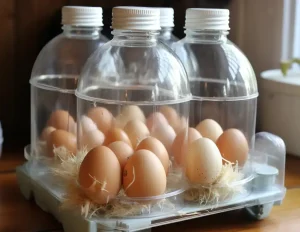Step-by-Step Guide:
1. Preparing the Bottle:
- Clean the plastic bottle thoroughly.
- Lay the bottle on its side and cut a large opening on the narrower side. This will act as the door for your incubator.
2. Setting up the Heat Source:
- Install small light bulbs or heat lamps through the top or sides of the bottle. Ensure they are secure and evenly distributed for consistent heating.
- Remember, the goal is to maintain a steady temperature of about 99.5°F (37.5°C).
3. Ensuring Egg Stability:
- Place a foam or an egg carton inside the bottle. This will hold the eggs in place and prevent them from rolling.
4. Monitoring Temperature and Humidity:
- Install a thermometer and hygrometer inside the incubator to keep a close watch on the environmental conditions.
- Aim to maintain a humidity level of around 45-55% during incubation and 65-75% during the last three days before hatching.
5. Ventilation:
- Drill small holes for ventilation. This ensures a steady flow of fresh air and aids in humidity control.
6. Manual Egg Turning:
- Turn the eggs manually at least three times a day to ensure even development.
Building a homemade incubator with a water bottle is not just a fun DIY project; it’s a practical and educational experience. By carefully monitoring and adjusting the conditions inside your incubator, you can successfully hatch eggs and witness the miracle of life firsthand.
Safety Tips:
- Always monitor the heat sources to prevent overheating.
- Keep the incubator out of reach of small children and pets.
Hatching eggs at home can be a rewarding experience. With your homemade incubator, you’re all set for an exciting adventure in the world of egg hatching.
LIRE LA SUITE..
